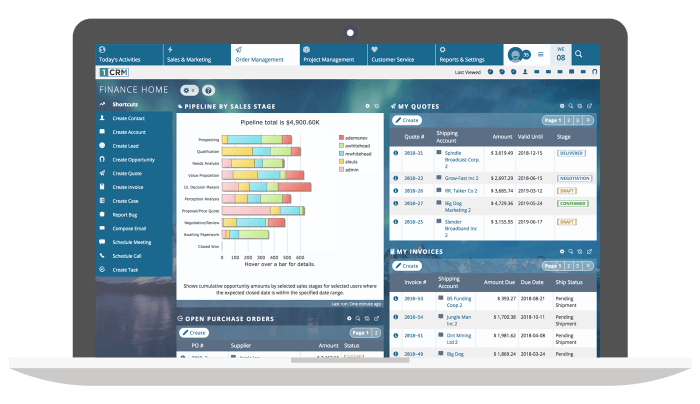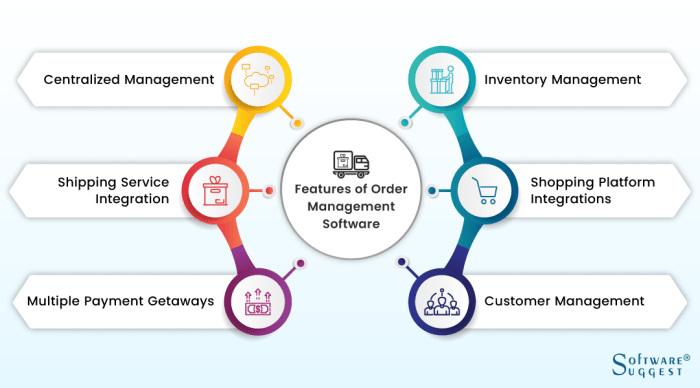Crm and order management software – In today’s dynamic business landscape, efficient management of customer relationships and orders is paramount for success. This necessitates the integration of robust Customer Relationship Management (CRM) and Order Management Software (OMS) systems. While often considered separately, these systems are increasingly intertwined, offering businesses a powerful synergy for improved operational efficiency, enhanced customer satisfaction, and ultimately, increased profitability. This comprehensive guide delves into the intricacies of both CRM and OMS, exploring their individual functionalities, the benefits of their integration, and how businesses can leverage them to achieve their strategic goals.
Understanding Customer Relationship Management (CRM) Software
CRM software acts as a central hub for all customer-related interactions. It helps businesses manage and analyze customer data, track interactions, and streamline sales processes. A good CRM system empowers businesses to understand their customers better, personalize their interactions, and improve overall customer experience. Key features include:
Core CRM Features:, Crm and order management software
- Contact Management: Centralized storage and management of customer contact information, including personal details, communication history, and purchase history.
- Sales Force Automation (SFA): Tools to automate sales processes, such as lead management, opportunity tracking, and sales forecasting.
- Marketing Automation: Automated email campaigns, targeted advertising, and social media management to nurture leads and boost conversions. This includes features like email marketing, social media integration, and marketing campaign tracking.
- Customer Service & Support: Tools to manage customer inquiries, track support tickets, and resolve issues efficiently. This often includes features like help desk integration and live chat capabilities.
- Reporting & Analytics: Detailed reports and dashboards to analyze customer data, track key performance indicators (KPIs), and identify areas for improvement.
- Integration Capabilities: Ability to integrate with other business applications, such as email marketing platforms, accounting software, and e-commerce platforms. This is crucial for a seamless workflow.
Types of CRM Systems:
- Operational CRM: Focuses on automating and improving business processes related to sales, marketing, and customer service.
- Analytical CRM: Utilizes data analysis to gain insights into customer behavior, preferences, and needs, enabling better decision-making.
- Collaborative CRM: Facilitates communication and collaboration between different departments within a business to improve customer service and satisfaction.
Understanding Order Management Software (OMS)
Order management software streamlines the entire order fulfillment process, from order placement to delivery. It provides a centralized platform to manage inventory, track shipments, and handle returns. A robust OMS improves efficiency, reduces errors, and enhances customer satisfaction by providing accurate order status updates and timely delivery.
Core OMS Features:
- Order Entry and Processing: Automated order entry and processing, reducing manual data entry and minimizing errors.
- Inventory Management: Real-time tracking of inventory levels, ensuring sufficient stock to meet demand and preventing stockouts. This includes features like automated stock replenishment and low-stock alerts.
- Warehouse Management: Managing warehouse operations, including receiving, picking, packing, and shipping orders. This can integrate with warehouse management systems (WMS).
- Shipping and Fulfillment: Integration with shipping carriers to automate shipping label generation, track shipments, and manage delivery schedules. This also includes features like carrier rate comparison and shipping label printing.
- Returns Management: Streamlined process for handling returns, including tracking return shipments and issuing refunds or replacements.
- Reporting and Analytics: Detailed reports on order status, inventory levels, shipping costs, and other key metrics to identify areas for improvement.
- Integration with E-commerce Platforms: Seamless integration with various e-commerce platforms to automate order processing and inventory updates.
The Synergy of CRM and OMS Integration
Integrating CRM and OMS systems creates a powerful synergy, offering businesses significant advantages. This integration allows for a holistic view of the customer journey, from initial contact to post-purchase support. Key benefits include:
- Improved Customer Experience: Providing personalized experiences based on customer data and proactive communication about order status.
- Enhanced Operational Efficiency: Automating repetitive tasks, reducing manual errors, and streamlining workflows across departments.
- Increased Sales and Revenue: Improved customer satisfaction leads to increased loyalty and repeat business, ultimately boosting revenue.
- Better Inventory Management: Accurate forecasting and inventory control minimize stockouts and reduce storage costs.
- Reduced Costs: Automation and efficiency gains reduce operational costs, including labor, shipping, and storage costs.
- Data-Driven Decision Making: Comprehensive data analysis provides valuable insights into customer behavior and business performance, enabling informed decisions.
Choosing the Right CRM and OMS Software: Crm And Order Management Software
Selecting the right CRM and OMS software depends on several factors, including business size, industry, specific needs, and budget. Consider the following:

Source: 1crm.com
- Scalability: Choose software that can grow with your business.
- Integration Capabilities: Ensure seamless integration with existing systems.
- User-Friendliness: Opt for software with an intuitive interface that is easy for your team to use.
- Customization Options: Select software that can be customized to meet your specific needs.
- Customer Support: Ensure reliable customer support is available.
- Cost: Consider both the initial cost and ongoing maintenance costs.
Frequently Asked Questions (FAQ)
- Q: What is the difference between CRM and OMS? A: CRM focuses on managing customer relationships, while OMS focuses on managing the order fulfillment process. While distinct, they are highly complementary.
- Q: Do I need both CRM and OMS software? A: While not always mandatory, integrating both systems provides significant benefits, especially for businesses with a substantial order volume and a focus on customer relationships.
- Q: How much does CRM and OMS software cost? A: Costs vary widely depending on the features, scalability, and vendor. Expect a range from affordable cloud-based solutions to enterprise-level systems with higher price tags.
- Q: How long does it take to implement CRM and OMS software? A: Implementation time depends on the complexity of the software and the size of your business. It can range from a few weeks to several months.
- Q: What are the key benefits of integrating CRM and OMS? A: Integration improves customer experience, operational efficiency, and data-driven decision-making, ultimately leading to increased sales and profitability.
Call to Action
Ready to optimize your business processes and elevate your customer experience? Explore the possibilities of integrated CRM and OMS software today. Contact us for a consultation to discuss your specific needs and find the perfect solution for your business.
Clarifying Questions
What are the key benefits of integrating CRM and order management software?
Improved efficiency, increased accuracy, enhanced customer satisfaction, better inventory management, and data-driven decision-making.
How much does CRM and order management software typically cost?
Pricing varies greatly depending on the features, scalability, and vendor. Expect a range from affordable cloud-based solutions to more expensive enterprise-level systems.
What are some common challenges in implementing CRM and order management software?
Data migration, integration complexities, user adoption, and ongoing maintenance requirements are common hurdles.

Source: amazonaws.com
How can I choose the right CRM and order management software for my business?
Consider your business size, specific needs, budget, and integration capabilities. Research different vendors and compare features before making a decision.
